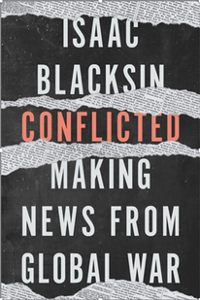Introduction
Isaac Blacksin is a media theorist and an ethnographer of military conflict. Operating at the convergence of media studies, cultural studies, and critical theory, his research examines the politics of representation and the practice of mass media in conditions of violence.
Biography
Isaac Blacksin is Assistant Professor of Critical Media Studies in the Department of Communication and Journalism. His first book, Conflicted: Making News from Global War, was published by Stanford University Press in 2024 and received the Best Book Award from the International Communication Association’s division of Philosophy, Theory & Critique. Based on years of ethnographic fieldwork with journalists in Iraq, Syria, Lebanon, Afghanistan, and Ukraine, the book shows why news of conflict, often presumed to function as a critique of excessive violence, instead serves to sanction official rationales for global war. Isaac’s newest project concerns the roles of simulation, fantasy, and popular culture in military training and armed conflict. Isaac’s fieldwork in war zones has received support from several prominent foundations and his research appears in various scholarly and popular venues, including Public Culture, Journalism, and Media, War & Conflict. Before joining Texas A&M University, Isaac was a Postdoctoral Fellow in the Society of Fellows at the University of Southern California and a Research Fellow at the Annenberg School for Communication’s Center on Communication Leadership and Policy. He received a Ph.D. from the History of Consciousness department at the University of California, Santa Cruz, and an M.A. in Religious Studies from Stanford University.
Courses Taught
- Mass Media and Politics
- Global Media
- Foundations in Humanistic and Critical Inquiry
Research Interests
- Humanities & Critical/Cultural Studies
- Media, Culture, and Identity
Selected Publications
Representative Publications
Blacksin, Isaac. 2024. “Extermination as Protection: Humanitarian Desire and the News from the Battle for Mosul.” Public Culture 36(2): 209-229
Blacksin, Isaac, and Saumava Mitra. 2024. “Straddlers not Spiralists: Critical Questions for Research on Fixers, Local-Foreign News Work, and Cross-Border Journalism.” Journalism 25(6): 1271-1289
Blacksin, Isaac. 2023. “Death’s Common Sense: Casualty Counts in War Reportage from Syria and Beyond.” Media, War & Conflict 16(3): 401-417
Blacksin, Isaac. 2022. “Agitation at the Margins: War, Reportage, and their Internal Contradiction.” HAU: Journal of Ethnographic Theory 12(2): 421-435
Blacksin, Isaac. 2022. “Brown Now: Communion, Mystery, and Public Knowledge.” boundary 2 49(3): 1-4
Blacksin, Isaac. 2022. “Violence, Magic, Certainty: A Journalistic Worlding.” In Geo-Spatiality in Asian and Oceanic Literature and Culture, edited by Serena Chou, et al., 95-114. New York: Palgrave Macmillan
Blacksin, Isaac. 2021. “Situated and Subjugated: Fixer Knowledge in the Global Newsroom.” Applied Journalism and Media Studies 11(3): 333-354
Blacksin, Isaac. 2021. “Afghanistan’s False Choices.” Viewpoint Magazine, fall issue (online)
Blacksin, Isaac. 2020. “Review of Caleb S. Cage, War Narratives: Shaping Beliefs, Blurring Truths in the Middle East.”Media, War & Conflict 13(4): 506-508
Blacksin, Isaac, and James Clifford. 2018. “Our Apocalypse, Our Metamorphosis.” UCSC Humanities Institute (online)
Blacksin, Isaac. 2013. “Contested Terrain: Development, Identity, and the Destruction of an Ancient City in Afghanistan.”Kyoto Journal 77: 36–51
Books
Blacksin, Isaac. 2024. Conflicted: Making News from Global War. Stanford, CA: Stanford University Press.

How is popular knowledge of war shaped by the stories we consume, what are the boundaries of this knowledge, and how are these boundaries policed or contested by journalists producing knowledge from war zones? Based on years of fieldwork in Iraq, Syria, Lebanon, Afghanistan, and Ukraine, Conflicted challenges normative conceptions of war by revealing how representational authority comes to be. Turning the lens on journalists from The New York Times, The Washington Post, and other prominent publications, Isaac Blacksin shows why news coverage of contemporary conflict, widely presumed to function as a critique of excessive violence, instead serves to sanction official rationales for war. As new wars, and new reportage, continue to shape our understanding of armed conflict, this book makes visible both the power and the particularity of war reportage.

